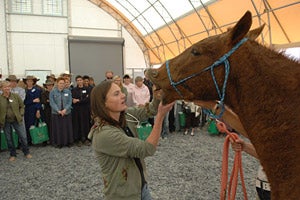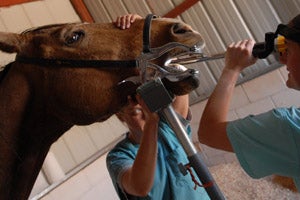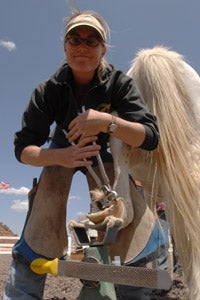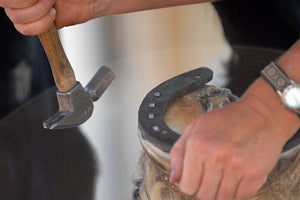Horse dental and hoof care

If their mouths and hooves are not properly cared for, life can be miserable for horses. Horse Haven knows this all too well. Scores of horses have landed at the horse area of Best Friends Animal Sanctuary afflicted with all numbers of dental and hoof problems.
Horse tooth care

Dr. Tara explains horse care at a first aid class.
Best Friends horse veterinarian Dr. Tara Timpson conducts the regular dental checkups for the horses at Horse Haven, keeping them in good dental health. She says that it’s vital for horses to have healthy teeth.
"Because their teeth are erupting, or growing, every year, they can easily have malocclusions," she says. Malocclusions are misalignments in opposing teeth. She says that one problem tooth can offset the entire grinding surface of the teeth, leaving a horse in so much pain that he can’t eat.
Dr. Tara thinks about 80 percent of the horses who come to Best Friends have not had proper dental care. She thinks that’s because good equine dental care is expensive and not many people know how important it is.
Horse in need of dental work
Curly Sue was one of those horses who needed dental work.

Waco gets a dental
Curly Sue came to Horse Haven in 2009 looking like she’d been through hell and back. She was filthy, emaciated and bald on several parts of her body, including her tail. She was in such bad shape that Horse Haven admitted her into the Guardian Angel program, in which animals with special medical needs receive individual support from Best Friends’ members and supporters. The specialized care she received has allowed her to retire from the Guardian Angel program.
But she had many endearing habits, one of which was dunking her hay in her water trough before eating it. No one knew why she did this until Dr. Tara conducted Curly Sue’s first dental exam and found a number of painful-looking lesions along the inside of her cheeks and on her tongue. Obviously, she had been dunking her food to soften it and make it less painful to chew.
Glossitis: Chronic tongue inflammation
The lesions turned out to be the symptoms of a condition called glossitis — that is, a chronic inflammation of the tongue. Curly Sue carries a genetic anomaly that makes her prone to a number of odd disorders, glossitis being one of them.
"Once we did some dental work on her and gave her a good, balanced chewing surface, the inflammation went down dramatically," Dr. Tara says. "She still has a low-grade glossitis — not nearly as severe as before — but we keep it in check with regular dental care."
Horse hoof care provided by certified farrier
Just as important as a healthy mouth are healthy hooves, which is why the horses at Horse Haven are lucky to have a trained and certified farrier — that is, a specialist in equine hoof care. Care of the feet involves trimming and balancing horses’ hooves and, if need be, fitting the animals with shoes. Jen Reid, manager of Horse Haven, is the farrier at Best Friends.

Jen trims Incitato's hooves.
The role of the farrier is crucial for a horse’s well-being since so much of the animal’s health depends on the condition of his feet. When a horse’s hooves aren’t properly maintained, lameness can, and often does, ensue.
"Horse hooves look quite simple from the outside, but they’re actually very complex structures with bones, tendons, ligaments and other soft tissues inside," Jen says. "It’s vital that anyone working on a horse’s feet understand how everything works together and how even small imbalances or distortions can have big long-term consequences for the horse."
Many of the horses Jen and her staff have cared for over the years landed at the Sanctuary with injuries and pathologies that could very well have been avoided had their hooves been better maintained.
Horse with hoof problems: Arthritis and spurs
One horse who now certainly benefits from Jen’s care is Waco, another former Guardian Angel animal.

Though Waco’s previous people did everything they could to help him, Waco still suffered from a range of hoof problems, including some arthritis in his pastern and coffin joints and spurs on his navicular bone. Moreover, his frogs (the part of the foot that serves as an arch support) were atrophied and covered in a bacterial liquid called thrush. What Waco needed was some intense farrier care.
From several x-rays and by using certain landmarks on his feet, Jen was able to analyze the imbalances in his feet and figure out how to most appropriately trim and exfoliate his hooves so he would have greater balance and be more comfortable walking and standing. After trimming his hooves, she fitted him with a special horseshoe called the clog. Made of a form-fitting plastic instead of hard metal, the clog helped take pressure off the joints in Waco’s feet, enhancing his comfort.
For more information on proper care for your horses, check out the resource section.
Come visit the Sanctuary and have an opportunity to volunteer at Horse Haven and more.
Photographs by Best Friends photographers